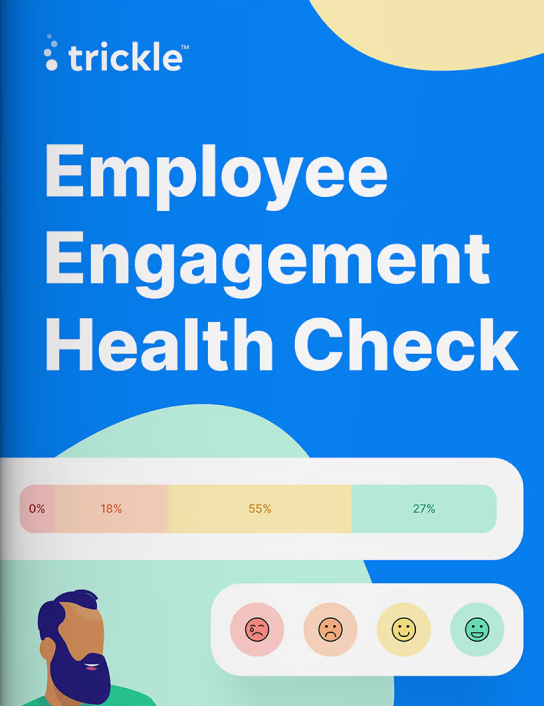How well does your company engage its employees?
Take your health check and find out.


In our latest blog, we discuss the seven signs of low employee engagement and how to fix it if you want to minimise the impact it has upon productivity.
Just as a high level of employee engagement can have a positive impact on the workplace, a low level can create an environment of negativity — resulting in lost productivity and even retention issues.
Low employee engagement can stem from events in the workplace or in an employee’s personal life. This can lead to negative effects in not only themselves, but also their team members.
While engaged employees are passionate about their work and do everything they can to push themselves and the company forward, disengaged employees have a very different outlook. They’re not committed or proud of the workplace and ultimately just don’t want to be there.
By recognising the signs of low employee engagement as early as possible, you can take action to address issues and help retain your best staff.
The first and most obvious sign of low employee engagement is a decline in the quality of their work. This can be judged in output or missed deadlines and isn’t something that can be easily hidden.
Instead of discipling the employee, have a chat to find out the issues that are causing them to underperform. Honest communication and working collaboratively is more effective than punishment.
It’s always best to do this at the first signs of disengagement, to prevent the situation getting worse and affecting the rest of the team.
Something that can have less of an immediate impact on productivity, but can still be a sign of disengagement, is an employee withdrawing into themselves.
A simple indication could be that they’re smiling less than they used to or have become less social with other members of staff. They could also seem distant and even silent in meetings or on calls. This is especially noticeable if the employee used to be passionate and outspoken.
It’s important to investigate these types of issues, as they could stem from conflicts between colleagues, or even bullying. If this isn’t the case, it could just show that the employee isn’t feeling connected with the rest of the team.
The opposite of an employee silently stewing away is one who is instead vocally angry, irritable or rude.
If a staff member is disengaged, it can lead to them lashing out over the smallest of issues, as they become less patient and understanding of others. They may also have a generally negative attitude to work and frequently shoot down other people’s ideas.
This can all come from an employee feeling that they are not listened to, feel undervalued in their role or may be due to problems outside of work. Either way, it’s best to try and address any underlying issues before they become bigger problems.
A trait that could be viewed as worse than negativity is complete apathy. When employees don’t care about their work or their company enough to even be angry, it’s a clear sign they’ve become disengaged.
This lack of commitment can be seen in an employee not participating in debates, not defending their ideas or a general sense of complacency.
Disengagement like this can come from burnout or exhaustion, so it’s always a good idea to check in with the employee to see if you can provide any help with their wellbeing.
When people become isolated from other team members and start to prioritise only themselves, it can be another sign of low employee engagement.
This could manifest in a reluctance to collaborate, a lack of participation in meetings, or even avoiding company social events.
An employee engagement tool like Trickle can make it easier for your workforce to collaborate and help you see when employee interaction takes a dip.
Employees who feel engaged will push themselves to learn and improve. They’ll take on new challenges and set themselves career goals. They’ll also be invested in the business and excited about the role they play within it.
Disengaged employees are very much the opposite. They have no enthusiasm for learning or innovation — their insecurity manifests in a desire to stick to the safety of their current situation, passing up opportunities to challenge themselves or progress.
Employees who want to progress in the company are more likely to demonstrate their desire to grow. Always look out for employees who are engaged and feed this motivation to grow. Some signs of an employee’s interest in progressing in their role include:
Nip issues in the bud by talking with employees to find out if their disengagement comes from issues with their workload, before it gets to a point they want to leave. Trickle’s “How Was Your Day?” feature is a simple way to engage with employees — simply ask the question and try to pinpoint what is causing a lack of motivation day-to-day.
Appearances can sometimes be deceptive, but if an employee is regularly not at their desk it can be a sign that they’re disengaged.
Taking breaks throughout the day and time off when you’re sick is very important for employee wellbeing, and you trust your staff not to abuse this.
If an employee is presenting signs of absenteeism, it’s always worth directly asking an them how they’re feeling and giving them the support they need to address any issues. Trickle’s MoodSense and How Was Your Day functions let you gauge employee feelings in real-time, helping you identify where grievances lie so that you can make edits to the way you work before employees become disengaged.
Using an employee engagement tool like Trickle is the ideal way to stop your employees getting disengaged. It gives everyone a voice to share their opinions and make suggestions. With two-way dialogue, you’ll resolve issues and make improvements naturally.
Trickles are posts where employees can raise issues, ask questions and post suggestions. People can stay anonymous, allowing them to raise concerns or reach out for support in a safe environment. Use Trickle to get regular feedback on all aspects of the business to help you spot issues early.
Our brains are hardwired for praise, so if employees aren’t receiving it, they can start to feel disengaged. Trickle’s Fist Bump feature is a great way to recognise someone for their efforts and encourage peer-to-peer support. All proven ways to increase job satisfaction, retention and boost morale.
We also encourage Shout Abouts. These spread positivity and boost engagement by sharing important company news and celebrating team wins. These announcements appear in the activity feed for everyone to see and celebrate virtually.
Trickle’s MoodSense feature lets you take a temperature check on how people are doing, giving you instant insights into areas that require action. Employees can also use Trickle to seek support on a work or personal matter that’s impacting their health or wellbeing and they can remain anonymous if they wish.
Get in touch for more information or to book a demo.